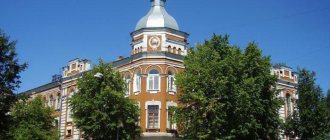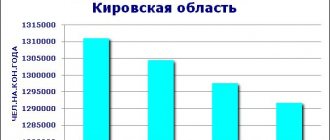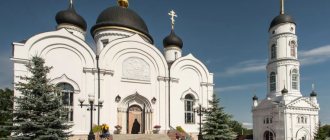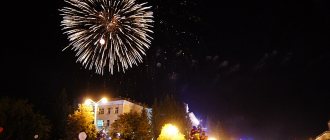Megion
The list of cities in the Tyumen region continues with Megion. The first mention of the settlement was in 1910. Modern development of the territory began during the “oil boom” in 1959. In 1980, the village received city status. The population according to the 2022 census is 48 thousand people - Megion is in 336th place out of 1114 cities in Russia.
Tyumen
Tops the list of cities in the Tyumen region in terms of population; the administrative center of the region is Tyumen. It is home to more than 768 thousand inhabitants. Tyumen is the first Russian city in Siberia. The date of its foundation is 1586. Over the past years, it has regularly topped the ranking of cities with the highest standard of living.
Nizhnevartovsk
Nizhnevartovsk continues the list of large cities in the Tyumen region, in which it ranks third in terms of population, with about 275 thousand people living here. The Nizhnevartovsk pier appeared on the right bank of the Ob River in 1909. Seven years after the discovery of the country's largest Samotlor deposit in 1965, the village was transformed into the city of Nizhnevartovsk.
Kogalym
The city of Kogalym was founded in 1975. The appearance of the settlement is associated with the discovery of oil fields in Western Siberia. The city is famous for the fact that, in addition to the main production facilities located, from 1991 to 1993 the local administration was headed by Sergei Sobyanin. 65 thousand people live in Kogalym.
Surgut
Surgut is not only one of the most populated cities (the population in 2022 is more than 360 thousand people), but also one of the oldest settlements in Siberia. It was founded in 1594. It ranks second in size in the Tyumen region. The city was a place of political exile: from the uprising of Stepan Razin to the Decembrists. Surgut plays an important strategic role in the oil and gas industry.
Tobolsk
Tobolsk , in the Tyumen region, regional subordination, regional center, 247 km northeast of Tyumen. Located in the center of Western Siberia. Port on the Irtysh, near the confluence of the river. Tobol, 14 km from the railway station of the same name on the Tyumen - Surgut line. Airport. Population 97.6 thousand people (1992; 20.4 thousand in 1897; 18.2 thousand in 1926; 32 thousand in 1939; 36 thousand in 1959; 62.5 thousand in 1979). Founded in 1587 by a detachment of Cossacks of Danila Chulkov near the so-called Chuvash Cape, where on October 23, 1582, a decisive battle took place between Ermak’s detachment and the army of the Tatar Khan Kuchum (a memorial obelisk to Ermak was installed in the park on Cape Chukman, 1835-39, architect A.P. Bryullov, height 16 m). In 1587, a wooden fort was built on the so-called Trinity Cape, which later became the core of a stone Kremlin, the first in Siberia. Until 1590 it was administratively subordinate to Tyumen. In 1590 it received city status. In 1600 it was moved to Cape Chukman. In 1606-09 a wooden log city was rebuilt. In 1643, 1677, 1680 it was completely destroyed by fires. From the end of the 16th century. until the 18th century - the main military-administrative, political and church (the Siberian Diocese was established in 1620) center of Siberia. T. was also a distribution and customs center, a point of transit trade between Europe and China (it also traded with Bukhara), and a place for collecting yasak; There were numerous tanneries, forges, and an arms factory. From 1708 - a city, the center of the Siberian province, stretching from the Urals to the Pacific Ocean, from 1782 - the Tobolsk governorship, in 1796-1917 - the center of the Tobolsk province. In 1773-74 it was a stronghold of the government in the suppression of the Peasant War in the Urals and Trans-Urals under the leadership of E. I. Pugachev. In the 19th century Due to the movement of trade routes and then the construction of a railway (away from the city), the economic importance of T. fell somewhat. By the end of the 19th century. in T. there were 2,332 houses (including 50 stone ones), there were 25 churches and the Znamensky Monastery, 15 educational institutions, 177 trade shops, a city museum, several printing houses were opened, and 48 factories and factories operated. The main occupation of the residents was fishing and processing fish, which was salted, dried, and frozen in winter and sent to Irbit, Yekaterinburg, Moscow, and St. Petersburg. Furriery (up to 1 million squirrel skins, as well as hare and fox skins) and mitten (sewing mittens from suede) trades were also developed. During the period of the XVII - early XX centuries. T. was the largest cultural, educational and educational center of Siberia: chronicles were written here, the first Slavic-Russian school in Siberia was opened in 1703, a theater was founded in 1705, a printing house operated, and the first Siberian magazine “The Irtysh Turning into Ipokrena” was published. In many ways, the cultural significance of T. was determined by the activities of exiles: in the 17th century. - Slavic publicist Yu. Krizhanich and archpriest Avvakum, in the 18th-19th centuries. — A. N. Radishcheva, P. A. Sumarokova, V. V. Passek; in the 30-50s. XIX century - Decembrists A.P. Baryatinsky, brothers P.S. and N.S. Bobrishchev-Pushkin, F.B. Wolf, S.G. Krasnokutsky, V.K. Kuchelbecker, A.N. Muravyov, P.N. Svistunov, I.A. Annenkov, N.A. Chizhov, S.M. Semenov, F.M. Bashmakov, M.A. Fonvizin (the memorial houses of Muravyov, Svistunov and Fonvizin have been preserved) and V.I. Shteingel. The composer A. A. Alyabyev, the scientist D. I. Mendeleev, the architect A. F. Kokorinov, the artist V. G. Perov, the cartographer, architect and historian S. U. Remezov were born in T., the artist V. I. lived and worked Surikov, poet and teacher P. P. Ershov (his house has been preserved; a sculptural monument was erected at the Zavalny cemetery), historian of Siberia P. A. Slovtsov, poet D. P. Davydov, musician N. Ya. Afanasyev, Ukrainian poet P. A. Grabovsky. In Tbilisi, from August 1917 to April 1918, the last Russian Emperor Nicholas II and his family were under arrest. Leading enterprises of modern T.: petrochemical plant, shipyard and ship repair plant, biofactory; wood processing plant, furniture, carpet weaving factories, enterprises for the production of building materials, food industry. T. is one of the centers of the Russian bone-carving craft, which has existed since the second half of the 19th century. (the first workshop of I. E. Oveshkov was opened in 1877); in T. - a factory for artistic bone carving (established in 1960 on the basis of the Tobolsk Bone Carver artel, founded in 1932), where they make boxes with relief ornaments, inlays and engravings, brooches, multi-figure compositions (round tabletop sculpture with miniature compositions of a genre nature ). Pedagogical Institute named after D.I. Mendeleev, branch of Kazan Technological University. In 1989, the only theological seminary in Siberia reopened in the city, and in 1990 the Tobolsk-Tyumen diocese was formed. Drama Theater named after P. P. Ershov. State Historical and Architectural Museum-Reserve (founded in 1870; until 1961 - Museum of Local Lore; now one of the largest in Siberia, over 200 thousand exhibits; rich archaeological and ethnographic collections, a collection of objects of decorative and applied arts, paintings, sculptures of Siberia and T .). The city is located in a bend of the river. Irtysh, on steep coastal slopes and the vast lowland of its right bank. The appearance of the city is determined by the dominant position of the stone Kremlin (late 17th - late 19th centuries) with large-scale religious and civil buildings standing on a high plateau and surrounded by walls with towers and battlements (the walls and several towers were restored in the 1970s-80s according to the project architect F. G. Dubrovin). The cult and church-administrative eastern part (the so-called Sophia courtyard), which made up the 1st stage of the stone construction of the Kremlin (1680-90s, architects G. Sharypin and G. Tyutin), is formed by: the most ancient stone structure of Siberia - the majestic the 5-domed Sophia-Assumption Cathedral (1681-86) with an emphatically geometric main volume and various decorative elements (in the interior there are paintings of the 1720-30s, presumably by St. Petersburg painters R. and I. Nikitin, the tomb of the first Siberian hierarchs); cathedral sacristy (1796-97); the main high-rise dominant of T. is the cathedral bell tower (1794-97, designed by architects A. Guchev and F. Utkin, height 75 m) with an 8-sided dome and rusticated corners; Baroque Intercession Cathedral (1743-46, expanded in 1850); 3-storey bishop's house (1773-75; now the Museum of Local Lore) in the style of classicism; 2-story Consistory (1787); the stone belfry of the “Uglich” bell, “exiled” to T. during the reign of Boris Godunov, and other buildings. At the 2nd stage of the construction of the Kremlin (1700-17, architect S. U. Remezov), its secular part, the so-called Small or Voznesensky city, was rebuilt: the Prikaznaya Chamber (1700, in the 1780s built into the 3-story palace of the governor) ; Gostiny (Menovoy) courtyard (1703-05) with an internal closed courtyard, 2 gates and 4 towers with battlements; Renteria, or Treasury (also “Swedish Chamber”; 1714-16, from the end of the 18th century - archive); in the same part there are Public Places (1828-31, designed by the St. Petersburg architect D. Visconti, including part of the governor’s palace, 1782, burned down in 1788). The main longitudinal highways of the northern, mountainous parts of Tashkent and the southern (the so-called lower city), as well as several radial streets, are oriented towards the Kremlin. The development of T. is of a regular nature, developed in the master plans of 1767 and 1784. In certain areas of the city, sections of earlier, free, picturesque buildings have been preserved, which constitute the special originality of T. The panorama of the mountainous part in the old T. is determined by the Spasskaya Church (1709-13) and the church Peter and Paul (1768-88, bell tower - 1807). Outside the old city, behind an earthen rampart with the remains of a ditch, in the Zavalny cemetery, there is the Church of the Seven Youths of Ephesus (1776) with rounded corners and rusticated pilasters. The high-altitude landmark of the foothill, commercial part of the city, which determined the riverine perspective of T., was the Znamensky Monastery (founded in 1596, on the modern site - from 1623), from which a 2-story cell building (1734-41) with the Kazan Church in the eastern end has been preserved (finished in 1768, the lower tier survived), the bell tower (1768, part of the quadrangle remained) near the western wall, the seminary building (1870s). To the east of the monastery, among the wooden buildings, there is a tiered, “octagon-on-quadrangle” type Church of the Nativity of the Virgin Mary (1744-61) with a bell tower on the basement. On the southern outskirts of T., in the former Cossack settlement, there are the baroque St. Andrew's Church (1744-59) and the 2-story, 5-domed (originally 9-domed) Church of the Exaltation of the Cross (1754-1771, interiors with rich decorative stucco molding - 1789) with a bell tower topped with a spire (1778-80). On one of the two main thoroughfares of the lower city, the former Pyatnitskaya Street, built up mainly with small wooden houses, there is the Church of Paraskeva Pyatnitsa (begun in 1762, classicism) and the Church of Zechariah and Elizabeth (1759-76, being restored), one of the best Baroque monuments in Siberia; to the east of it is the Church of Michael the Archangel (1745-54, built by the Tobolsk coachmen Cherepanovs), 2-tier, with an external entrance, with rich facade decoration and a baroque openwork fence. Civil buildings in the Baroque style: merchant magistrate (mid-1750s), similar in form to early Petrine architecture; Bogoroditskaya (Bogoyavlenskaya; after the name of the church dismantled in the 1930s) almshouse near the Kurdyumka river under the mountain. Monuments of private stone construction in T. of the second half of the 18th century: Khudyakov’s house (late 1750s) with baroque architraves on the 2nd floor; 2-storey house of the Volodimirovs (late 1760s, after 1788 - a government pharmacy) with elegant facades in the style of Peter the Great’s Baroque; provincial gymnasium (until 1788, rebuilt in 1824, originally the Korniliev house, then the residence of the governor and the Main Public School), garrison hospital at the earthen rampart (1776). In the center of Podgornoye T. monuments play an active role: classicist - the former house of Smorodinnikov-Dranishnikov (late 18th century) in transitional forms from baroque to classicism, the 3-story house of Severyukov (1788, rebuilt in the 1820s), 2-story house of the Governor General (1788, originally Kuklin's house); in the spirit of eclecticism and modernism - a brick church (second half of the 19th century, neo-Gothic), originally the building of the Museum of Local Lore (1887-88, pseudo-Russian style), a 2-story Kornilov mansion (now a bank, second half of the 19th century, neo-Renaissance), the former women's gymnasium (1915, late modern). In Tashkent, significant areas of wooden residential buildings from the 19th and early 20th centuries have been preserved. with 2-story houses decorated with saw carvings. Since the 1960-70s. T. was actively built up in a northern direction, along Alafeyskaya Mountain. Among the large buildings of this period, the railway station located far to the north (1974) with a long-span folded hall floor stands out. According to the master plan for the development of T., protected protected zones have been established, including the landscape surrounding the historical part of T., it is planned to create a new public center much to the north of the Kremlin, with the removal of new buildings beyond the boundaries of the old city. 8 km north of T. is the Suzgun hill with archaeological monuments - an ancient sacrificial site and the remains of a bronze foundry (circa 10th-8th centuries BC). On the Chuvash Cape south of T. there is the site of Potchevash (second half of the 1st millennium) and a burial mound of 17 mounds (IV centuries BC - 1st-2nd centuries AD). 20 km east of T., along the former Omsk postal route, behind the village of Alemasova, on the right bank of the Irtysh, near the Sibirka River, the semi-eroded Isker Hill (also Kashlyk, Siberia), the site of an ancient settlement (first quarter of the 2nd millennium) and capital of the Siberian Khanate (XVI century, excavations 1915). 12 km southeast of T., on the left bank of the Irtysh and the Shantalyk river, is the former Ioannovsky (John the Vvedensky) monastery (founded in 1653) with an empire-style cathedral (1808-12), the winter Vvedensky church at the abbot’s corps (1790 , rebuilt in 1853), 2 monastic buildings (1752, with the 2nd floor added in 1811), a quadrangular fence (1805-06) and a domed pavilion over the “Holy Well”. 30 km east of T., in the village of Preobrazhenskoye, is the Church of the Transfiguration of the Savior (1770s), the figured head of which and the end of the quadrangle are reminiscent of the Zakharyev Church in T. Not far away, on the steep left bank of the Irtysh, in the village of Abalak, the former Znamensky Monastery (from 1636 - a graveyard; monastery - from the end of the 18th century), a famous center of pilgrimage to the miraculous icon of the Abalak Mother of God: the Znamensky Cathedral (1683-91) with a heavy dome on a low octagon; Trinity Church (1748-50); bell tower with the “Holy Gate” (1752-59; height 38 m) with a gallery-promenade in the 2nd tier; stone fence (1825); residential buildings, a hotel and services (XIX century) on the sides of the extensive monastery courtyard. In the northern suburbs of T. there is the former Bishop's Grove with the remains of the country church of the Tobolsk bishop (18th century).
Cities[ | ]
| № | Name | city (outside the region)[5] | urban district[6] | population (persons) | founding/first mention | city status | coat of arms |
| 1 | Zavodoukovsk | city of Zavodoukovsk[3] | Zavodoukovsky urban district | ↘26 477[4] | 1729 | 1960 | |
| 2 | Ishim | Ishim city | Ishim city, urban district | ↘64 010[4] | 1687 | 1782 | |
| 3 | Tobolsk | city of Tobolsk | Tobolsk city, urban district | ↘98 772[4] | 1587 | 1782 | |
| 4 | Tyumen | Tyumen city | Tyumen city, urban district | ↗816 700[4] | 1586 | ||
| 5 | Yalutorovsk | Yalutorovsk city | Yalutorovsk city, urban district | ↘39 947[4] | 1659 | 1782 |











